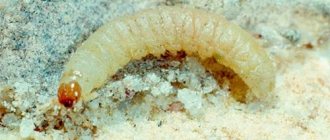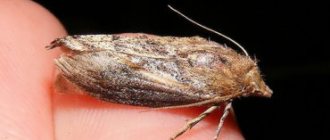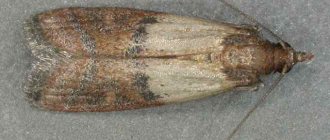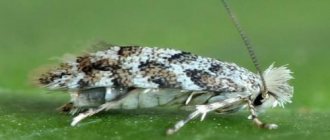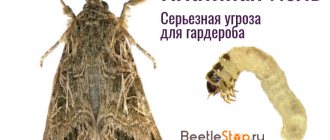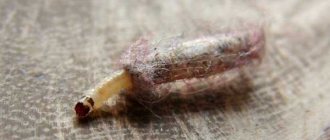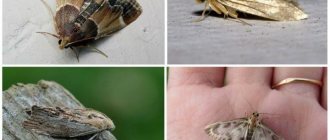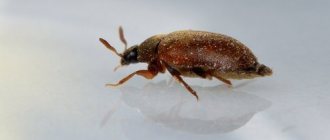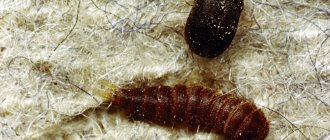Furniture and clothes moths destroy products made from wool, fur and natural raw materials. Some species consume furniture upholstery and damage carpets. These types of pests are classified as keratophagous because in their natural environment they consume feathers, down and six from animals and birds. When moving to a country house or apartment, insects switch to a different diet. If you do not actively combat pests, they will quickly spread and spoil things. In order to achieve success, you need to clearly know what furniture and clothes moths look like.
First look at clothes and furniture moths
Clothes and furniture moths have similar characteristics. Their body length reaches 5–10 mm. The body color is straw yellow. Adults of the furniture species are darker in color. Such insects have darkening on their wings. The color of the dress does not change throughout the entire period of existence. It is difficult for an ordinary person who does not have microscopes and other devices to distinguish one species from another. The difference between furniture moths and other pests is that wings are present in female as well as male moths.
The damage is caused by the larvae of clothes or furniture moths, not the adults. They consume lint, form holes and passages in fur coats, sweaters and furniture upholstery. Therefore, all housewives should know what clothes or furniture moths look like.
Lavender against moths
A time-tested remedy is lavender for moths. Both lavender essential oil and dried branches are used. Lavender essential oil is present in perfumes, toilet soaps, skin care products, and hair care products. At the same time, moths cannot tolerate the smell of lavender.
How it helps
Lavender against moths can be a beautiful solution to the problem. Lavender helps against moths no worse than mothballs, but at the same time it gives the closet and things a pleasant light aroma. In addition, lavender bouquets look like pleasant decorative elements. Moths cannot stand the smell of this beauty, so they will not settle in places where this aroma is heard.
The plant has a long-lasting effect and is completely safe for humans.
How to use
If housewives have chosen lavender for moths, there are several ways to use it. All you have to do is turn on your imagination. It is recommended to add 20 drops of lavender essential oil to 1 liter of water during wet cleaning and wipe cabinets and other surfaces.
If you have lavender flowers, you can make a sachet and put it on the wardrobe. If you don’t have bouquets of lavender, then lavender essential oil for moths can be a good substitute. The housewife can sew a simple bag herself and fill it with cotton wool previously soaked in essential oil. This will not only serve as good protection against moths, but will also look aesthetically pleasing.
Moth larva and eggs: how and where to find them
Moth caterpillars in the apartment extract nutritional components from fur, wool and other natural materials. They do this very well because they have the required equipment:
- Strong mandibles that are of considerable length. These two outgrowths are used by the caterpillars to separate part of the lint or fiber, which the caterpillars then feed on. Since the mandibles are supplemented with teeth, their effectiveness is increased.
- Powerful muscles of the oral apparatus. They are dispersed throughout the head, so the pressure they create is quite high.
- Huge intestines. A considerable amount of lint and other food is placed in it at a time.
It is possible to distinguish the furniture type from the clothing type only at the larval stage of moth development. After all, clothing caterpillars form protection from organic secretions and food debris, and furniture larvae use intact fibers for these purposes. Leaving the boundaries of the formed cocoon, the worms crawl to a minimum distance. They choose darkened corners where the sun's rays do not penetrate. If clothes with small pests are brought into the light, they actively hide in the folds.
The life cycle of the larva largely depends on nutrition. The growth period is from 18 to 21 days. During this period, the larvae molt from 10 to 13 times. The next stage is the appearance of the pupa. The development period increases 2–4 times if the larvae feed on synthetic fibers. The duration of the life cycle is affected by both temperature and humidity level in the room. Therefore, it is easier to fight moths in cold weather.
How to get rid of moths at home
If you notice that this moth has appeared in the house, then it’s time to take some action. You can, of course, test your dexterity and try to catch a butterfly. But all this will be ineffective, because the male usually flies around the room, and the female lays eggs at this time. After a week, they will hatch into hungry larvae.
To remove this parasite, you can use industrial pesticides or traditional methods of controlling this pest. The toxicity of insecticides is known to everyone, so it is better to use traditional methods that our great-grandfathers used. They show their effectiveness against moths and do not harm people.
Important point! Before using one of the traditional methods to deal with this pest, it is necessary to carry out a general cleaning of the apartment: wash all drawers and cabinets, air out clothes. Particular attention should be paid to dark and damp corners where the parasite likes to settle.
First, thoroughly clean the upholstered furniture, sort through and reshuffle books, bedding, and blankets. Dry the carpets in the sun and beat them thoroughly. Use dry cleaning services to get your outerwear in order for winter and off-season.
What moth repellents are recommended for use in an apartment:
- Garlic cloves. The pungent garlic smell irritates delicate butterflies, so by placing cloves of garlic in cabinets and cabinets, you will forever discourage the pest from wanting to settle in them.
- Orange peels. They contain essential oil, the smell of which moths also cannot tolerate. The butterfly will not lay eggs if it smells it.
- Tansy flowers. Tansy is a poisonous odorous plant that is used to repel it. These harmful insects will avoid those places where small bouquets of this plant are located.
- Table vinegar. Moths cannot stand the smell of vinegar. Therefore, during cleaning, it is advisable to treat all surfaces of the cabinets with vinegar and ventilate well. To enhance the effect of the procedure, you can wash the floors with vinegar.
- Geranium (pelargonium) sprigs. This is its main enemy, which is why our grandmothers loved to grow the flower on the windowsill and lay out the branches of the verge in the closets. Many insects cannot tolerate the ethereal vapors emanating from its leaves. Sometimes it is enough to keep pelargonium on the windowsill of each room to repel moths from your home.
- Dry spices (pepper, cloves). They also have a specific scent that she doesn't like. Small bags of spices placed around the apartment will help repel the pest.
- Sprigs of lavender. Even when dried, lavender has a persistent odor that humans sympathize with, but is extremely unpleasant for insects. Just spread the grass in inconspicuous corners and enjoy the smell, and not the flight of fluttering moths in your house, which will certainly leave it from such aromatherapy.
- Pieces of laundry soap. The soap smells of alkali, and it irritates her. Therefore, feel free to place soap in your closets so that the smell permeates things. When there are no moths, clothes should be ventilated. Laundry soap can also be placed in closets and pantries.
- Naphthalene tablets. They emit a peculiar repellent odor. Our grandmothers put things in chests mixed with mothballs to protect their things from damage.
- Perfume bottles. They retain the scent for a long time after using perfume, and they can be placed in wardrobes.
- Hot sun and severe frost. The moth cannot tolerate both very high and very low temperatures and dies. Therefore, you can use the power of nature to combat this pest. Winter clothes, carpets and blankets can be taken out to the balcony and frozen there for several hours. The temperature must be at least -20C. The same can be done on very hot days. In this case, it is necessary to ensure that during these hours things are in direct sunlight.
- Fresh newspapers. The smell of printing ink also repels her. To prevent insect larvae from “eating” your natural winter boots, you need to fill them with crumpled newspapers.
Video:
Moth nutrition and the main harm from it
Furniture moths do not feed at the adult stage, since these insects have underdeveloped mouthparts. The larvae that emerge from the eggs consume food that is located in the immediate vicinity. To obtain nutritional components they use textiles, wool and fur products. Since it is difficult for caterpillars to move through items made of wool and fur, or through pictures of furniture, they form peculiar passages. They cannot use those items of clothing that are entirely made of synthetics. Indeed, without natural components, the development process stops or proceeds more slowly. There have been cases where caterpillars did not molt and did not turn into pupae due to inappropriate nutrition.
Features of the use of folk remedies
Before you understand how to get rid of moths using folk remedies, it is important to understand what type they are. Almost all folk remedies are aimed at repelling pests, but are not capable of destroying them. In addition, when choosing a folk remedy, you should take into account that some can be adjacent to food, while others are better used where food supplies are not available.
Almost always in the household you can find something that moths are afraid of, and not give it the opportunity to reproduce in the apartment. But even if the necessary component is not available, it can always be easily purchased without a significant impact on the family budget. If the fight is not started in time, this parasite will quickly multiply and ultimately ruin all food supplies or valuable wardrobe and household items.
Reproduction and lifestyle of the pest
During the breeding season, the male looks for a female. A distinctive aroma is used as a guide. The clutch is formed 3–5 hours after mating. One female forms 3 or more clutches. The number of eggs depends on the type of pest. For example, furniture moths lay about 290–300 eggs, while clothes moths lay no more than 60.
Mating and reproduction occurs year-round. At the same time, the speed of development of caterpillars depends on conditions, external factors and seasonality. Some types of insects go into a kind of hibernation for 3–5 months.
Prevention of occurrence
Taking preventative measures is always easier than getting rid of the consequences of emerging pests. That's why:
- Regularly “shake up” your clothes, wipe down the shelves and drawers where they are stored.
- Treat winter items before storing them for the season.
- Keep kitchen cabinets clean, remove spilled cereals and crumbs in a timely manner.
- Place purchased bulk products into sealed containers.
- Get rid of old clothes and expired products in a timely manner.
- Do not store used clothing in the same place as clean, put-away clothing.
- Place plates, tablets, soap, aroma, spices, cedar balls or hangers in the cabinets.
Start taking action as soon as you notice the first signs of the presence of moths: this way, the chances of removing insects quickly and without loss to the family budget are much higher.
Struggle
Although the larva does not look too dangerous outwardly, the fight against it must begin as soon as the first signs of its appearance are noticed. Methods to combat it are quite simple and effective.
It can be removed by treating furniture, carpets and clothing with chemicals sold in any hardware stores. After processing and keeping for a certain time, things must be washed, and the furniture must be thoroughly washed.
The larvae do not hold onto clothing tightly, so even with normal shaking they begin to fall. If you hang things out in the sun or frost, the caterpillars will die. How to deal with moth larvae:
- Shake all your clothes.
- Warm up in the sun or wash at a temperature of 50 degrees.
- Spray clothes and closets with insecticides.
- Use scented repellents to prevent insects from re-invading.
Fighting food moths is somewhat more difficult. It is impossible to poison the larvae with chemicals, since the poison will get into the food. The following set of measures should be taken:
- Throw away all bags and packaging containing caterpillars;
- Kill all visible butterflies;
- Treat food storage areas with aerosols against flying insects;
- Wash cabinets with soapy water;
- Do not purchase a large stock of products.
Traditional methods for fighting moths
Folk remedies for moth control include the use of fragrant plants such as lavender
,sagebrush
,
coriander
_
It is also worth applying tea tree
or
pine
; they are not tolerated by insects and are repellents.
The aroma of these herbs is not tolerated by insects, and moths will definitely not breed where they are spread. When treating contaminated surfaces, vinegar
and
chlorine-containing preparations
.
Wipe the cabinet shelves with a vinegar solution and wash all free surfaces. The smell of chlorine kills insects instantly, so place a container with an aqueous chlorine solution in the closet for several hours. with a quartz lamp
copes well with the problem of the appearance of moths ; the larvae do not tolerate ultraviolet rays and die in almost a few minutes of lamp operation.
Reasons for the appearance of insects in the house
These small animals like to live in various types of crevices, and if your house is full of such places, then the likelihood of moths appearing and actively breeding is high. Therefore, one of the main preventative measures against moths is to seal and seal all the cracks in your home. Another factor that mainly influences the appearance of these insects is lighting. Dark rooms and poorly lit areas that are full of crevices are an ideal haven for moths and create favorable conditions for them to breed.
If you have indoor plants inside your home, this may be another reason for the appearance of insects, since some species of these lepidopterans feed on the nectar of flowers at a certain stage of development. One example of this species is the Miller's moth.
In some cases, moths may appear in our home due to things already infested with it, for example, the insect may be in fabrics or food that we bring into the house. In this case, we ourselves are the cause of the appearance and subsequent reproduction of this insect in our home.
